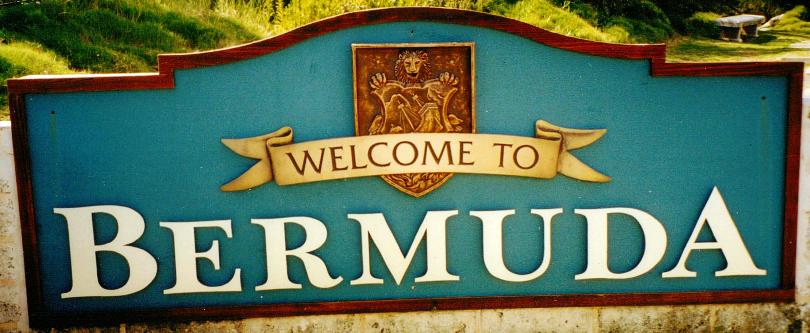
Click on graphic above to navigate the 165+ web files on this website, a regularly updated Gazetteer, an in-depth description of our island's internally self-governing British Overseas Territory 900 miles north of the Caribbean, 600 miles east of North Carolina, USA. With accommodation options, airlines, airport, actors, actresses, aviation, banks, beaches, Bermuda Dollar, Bermuda Government, Bermuda-incorporated businesses and companies including insurers and reinsurers, Bermudians, books and publications, bridges and causeway, charities, churches, citizenship by Status, City of Hamilton, commerce, communities, credit cards, cruise ships, cuisine, currency, disability accessibility, Devonshire Parish, districts, Dockyard, economy, education, employers, employment, environment, executorships, fauna, ferries, flora, former military bases, forts, gardens, geography, getting around, golf, guest houses, highways, history, historic properties, Hamilton, House of Assembly, housing, hotels, immigration, import duties, internet access, islands, laws, legal system and legislators, main roads, marriages, media, members of parliament, money, motor vehicles, municipalities, music and musicians, newcomers, newspaper, media, organizations, parks, parishes, Paget, Pembroke, performing artists, residents, pensions, political parties, postage stamps, public holidays, public transportation, railway trail, real estate, registries of aircraft and ships, religions, Royal Naval Dockyard, Sandys, senior citizens, Smith's, Somerset Village, Southampton, St. David's Island, St George's, Spanish Point, Spittal Pond, sports, taxes, telecommunications, time zone, traditions, tourism, Town of St. George, Tucker's Town, utilities, water sports, Warwick, weather, wildlife, work permits.
By Keith Archibald Forbes (see About Us).
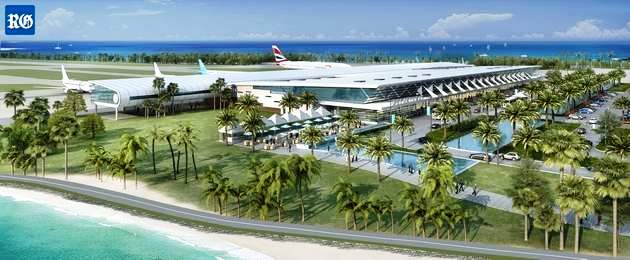

New L. F. Wade International Airport, Bermuda
Planned new airport, being Canadian built, construction of which began in April 2017 and is expected to be completed in lare 2020. Airport position, title and address: 32°22´00"N, 064°41´00"W. L. F. Wade International Airport, Bermuda. 3 Cahow Way, St. George's Parish, Bermuda. With International Air Transport Association (IATA) designation of BDA with International Civil Aviation (ICAO) designation of TXKF. IATA refers to it as in North America.
Bermuda is 568 miles east of North Carolina, 693 miles south east of New York, 770 miles south east of Boston, 788 miles north east of Nassau (no direct connection by air but via the USA), 1115 miles south east of Toronto, 1290 miles north of Puerto Rico (no direct connection by air but via the USA), 2055 miles from Winnipeg (no direct connection by air but via Toronto) and 2996 miles from London, England (with direct British Airways only flights)
Bermuda is 900 miles north of the Caribbean, with no direct Caribbean flights. Bermuda has always been in British North America according to all official British records.

Approaching Bermuda by air
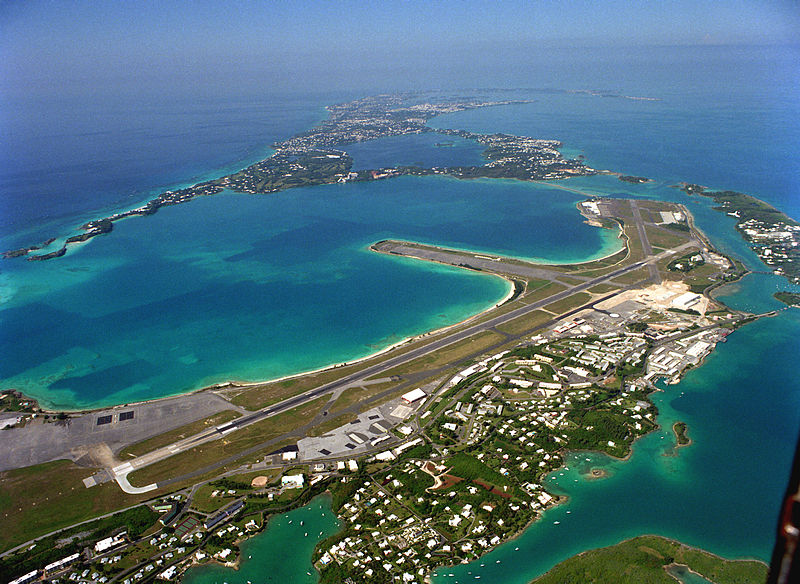
Bermuda International Airport and runway taken by USNAS Bermuda in 1993
![]()
Work on the new airport terminal is in its final push towards a fall 2020 construction completion. About 300 people are working on the site as the $250 million project nears completion. Road access to the new-look airport will be from the same roundabout as is used today. Trees have been moved from the old terminal site and replanted as part of the landscaping work in front of the new building. A large pond will not only be decorative, but will also take the overflow from the water tank that will collect rainfall from the terminal roof for use inside the building. Passengers scheduled to leave from the airport will see 23 “smart” check-in desks, designed for use by different airlines depending on demand and clusters of self check-in kiosks, some of which have already been installed, will take the weight off the lines. The terrazzo-tiled floor has been laid, but was still under protective covers as work continued. Departing passengers’ route through the airport will be marked by decorative longtails suspended from the ceiling — incoming travellers will follow kites. Dropped-off bags will be taken to the right place in an automated process, involving conveyor belts and scanners. The system, made by Glide path, a New Zealand company, reads baggage tags to direct luggage along belts to the right aircraft. Luggage is simultaneously scanned for security purposes. If the system detects anything suspicious, the bags are diverted to an area where staff will be able to make further checks before clearing the bags to continue their journey. Travellers in the security area will find four belt scanners and two body scanners, all of which have yet to be installed. Mr Westwood added that shoe removal and laptop examinations will no longer be necessary, thanks to state-of-the-art technology. The US Immigration pre-clearance area will be past security to the left and the stairway and elevator to the international departure lounge, for those travelling to all non-US destinations, will be on the right. The departure lounges stretch the length of the building from north to south, with fixed seating, retail outlets and a restaurant with outdoor seating area at each end. The sizes of the US and international lounges were adjustable. If a cluster of flights were US-bound, for example, the US lounge could be extended to up to 70 per cent of the total area by using sliding panels to wall off appropriate areas. High-tech systems should also give incoming travellers a smoother experience passing through the new airport. A total of six “e-gates”, with passport scanners and glass doors, are about to be installed in the arrivals hall, which will automate the passport control with a system similar to the one used at London’s Gatwick Airport. The façade of the new terminal is designed to stand up against sustained winds of more than 170mph.
2020. January 30. Air arrivals are to be screened at the airport as a killer virus from China continued to spread. The screening will include questions on areas travelled through in the previous 21 days and if the arrival had suffered any suspicious symptoms. The move, announced yesterday, came as the Ministry of Health confirmed the island had no known or suspected cases of coronavirus, which has killed more than 170 people and infected about 7,000 people around the world. The news came after a traveler arrived home on Sunday from a flight with a connection in Hong Kong and said airport staff needed to “elevate caution, without overreacting”, because she was not questioned about her itinerary. Air travel restrictions from China were imposed yesterday to limit the virus, coded 2019-nCoV and known as the Wuhan coronavirus after the city where it was first spotted. Bermuda’s state of alert was elevated on Monday, and Ms Collins said had felt no need to identify herself at the airport because she had not been in any affected area in the Philippines. A spokeswoman for the health ministry said “various disciplines and sectors of society”, along with airport customs, immigration, and airport operators Skyport, had been warned about the possible arrival of the virus in Bermuda. She added travellers arriving in Bermuda would be monitored and assessed if they were thought to be at risk. The spokeswoman said: “Those who have spent time in jurisdictions considered at very high risk, will be given health instructions for follow up and advice on self-monitoring for illness for 14 days. The public should know that there is a health officer at the airport, to assist with managing the situation at the port of entry and airport officials are in continuous communication with the epidemiology and surveillance unit.” A spokeswoman for Skyport added that TV screens at the airport arrivals area will be used to advise air arrivals.
For more information on airport redevelopment see Timeline of reconstruction below.
![]()
No rental of light aircraft is allowed.
![]()

En route to Bermuda, your airline will give you an exceptionally detailed form compared to other countries. You are required by the Bermuda Government to complete all the information shown The form must be completed by all tourists, visitors and returning residents
 On
arrival from the USA. Canada and United Kingdom - the only countries flying to
Bermuda - passengers go through lines for visitors, not those for
returning Bermudians or residents, to Bermuda Immigration where their applicable
flight forms are collected and passports are inspected. The
first line requires all Bermudian passport holders to contain the Bermudian status
stamp. Those without acceptable or adequate current documentation
such as valid passports or on an
FBI or Interpol stop list will be stopped and detained instead of being allowed
to enter. There have been cases of people arriving and purporting to be Bermudian but who
do not have Bermudian status – only a British or Bermuda passport stating they
were born in Bermuda, which, unlike in all other countries, does not entitle
them to citizenship. Business
visitors attending meetings here also have a separate line. The airport has a
dual-channel, red/green system for arriving passengers.
On
arrival from the USA. Canada and United Kingdom - the only countries flying to
Bermuda - passengers go through lines for visitors, not those for
returning Bermudians or residents, to Bermuda Immigration where their applicable
flight forms are collected and passports are inspected. The
first line requires all Bermudian passport holders to contain the Bermudian status
stamp. Those without acceptable or adequate current documentation
such as valid passports or on an
FBI or Interpol stop list will be stopped and detained instead of being allowed
to enter. There have been cases of people arriving and purporting to be Bermudian but who
do not have Bermudian status – only a British or Bermuda passport stating they
were born in Bermuda, which, unlike in all other countries, does not entitle
them to citizenship. Business
visitors attending meetings here also have a separate line. The airport has a
dual-channel, red/green system for arriving passengers.
All arriving passengers must tell Immigration if they are visitors or salespeople or corporate representatives. If they are not Bermudian and not strictly on vacation, they must produce Bermuda Government Work Permits. Do not attempt to try to use your visit to see any client or conduct any business in Bermuda without having the required Work Permit if you are not Bermudian.
At Bermuda Immigration, in what appears to be a system unique to Bermuda (it is not in effect at any UK or USA or Canadian airports) arriving passengers receive a card from an Immigration officer to indicate what type of inspection of baggage will occur. It appears as if each Immigration officer makes a pre-determination on what kind of profile or category of passenger applies.
 Travelers with no more
than their duty-free allowances, no prohibited or restricted goods, and no more
than $10,000 (or equivalent) in cash or negotiable instruments can go through
the green channel. Those with goods that exceed their $200 per
passenger duty-free allowances, goods for business use, prohibited or restricted
goods, or more than $10,000 (or equivalent) in cash or negotiable instruments
must use the red channel. Then they take taxis
or minibuses to get to their hotels or guesthouses or wherever else they are
staying, or are met by friends or family. There are no rent-a-car or public
transportation services for passengers with luggage.
Travelers with no more
than their duty-free allowances, no prohibited or restricted goods, and no more
than $10,000 (or equivalent) in cash or negotiable instruments can go through
the green channel. Those with goods that exceed their $200 per
passenger duty-free allowances, goods for business use, prohibited or restricted
goods, or more than $10,000 (or equivalent) in cash or negotiable instruments
must use the red channel. Then they take taxis
or minibuses to get to their hotels or guesthouses or wherever else they are
staying, or are met by friends or family. There are no rent-a-car or public
transportation services for passengers with luggage.
Rental automobiles allowed in Bermuda only if they are tiny, two-seater only and electric. They cannot be rented at the airport. Public transportation buses do not take passengers to hotels or other accommodation and are not equipped to carry luggage or wheelchairs or mobility scooters for the disabled. There are no courtesy hotel vans or limousines. Visitors get to their destinations by taxi or pre-arranged mini-bus or if seeing friends or family, in the family's sole private car.
![]()
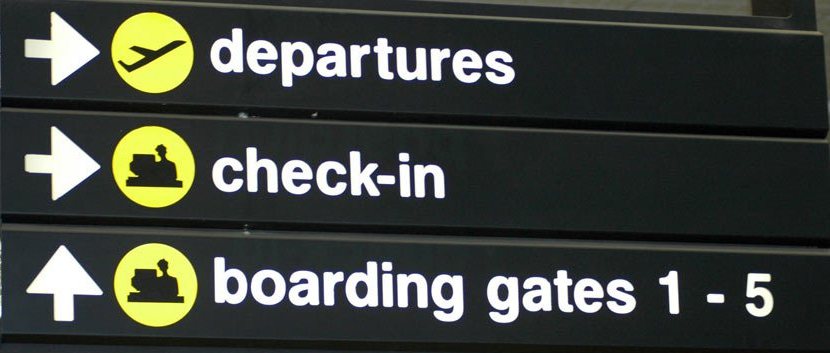
 Departing
passengers should check in to the airline ticket counter two hours before
their departure times, to avoid being refused if they arrive too late to be
questioned, screened and processed. Passengers arrive at
Departures by taxi or mini-bus or, if staying with friends, by private
car. Areas designate each commercial airline serving Bermuda. On the ground floor are
check-in facilities. Most departing passengers are
tourists, bound for the USA. Others
go on business or pleasure or to shop in the USA. Passengers check in at their
airline counters.
Departing
passengers should check in to the airline ticket counter two hours before
their departure times, to avoid being refused if they arrive too late to be
questioned, screened and processed. Passengers arrive at
Departures by taxi or mini-bus or, if staying with friends, by private
car. Areas designate each commercial airline serving Bermuda. On the ground floor are
check-in facilities. Most departing passengers are
tourists, bound for the USA. Others
go on business or pleasure or to shop in the USA. Passengers check in at their
airline counters.
To USA cities, Toronto and London served by the airlines. USA-bound passengers go through US Customs & Immigration pre-clearance in Bermuda, Passengers going to Britain or Canada will encounter Immigration and Customs clearance when they arrive in London or Toronto. In the United Kingdom, there are no longer European Community lanes.
Departure Taxes. $70-plus per person. The tax is payable by departing residents and visitors. How it is paid can vary. Some passengers may pay it directly to the airline who will then pay the Bermuda Government. Or it can be included in the overall cost of the ticket. Built into airline passenger tickets are other - hidden - taxes such as the Airport Security fee per passenger and a Passenger Facility Charge (PFC)..
![]()
![]()
Shows history not shown on the airport official website.
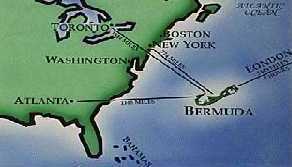
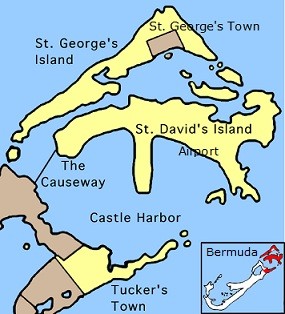
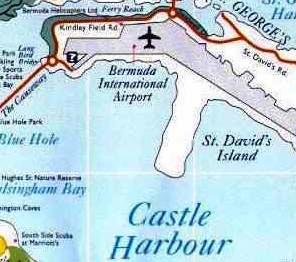
Built entirely at US taxpayers' expense as a US$42 million project in 1941-42 during World War 2, by amalgamating, creating dredging and eliminating many small islands in Bermuda's Castle Harbour. It and much other associated acreage was created to provide for the first time in Bermuda a land-based airfield for US military aircraft. The runways and taxiways were constructed from scratch from former small islands in Castle Harbour by engineers contracted by the US Army Air Corps. They built Fort Bell, later known as an USAAF base then Kindley Air Force Base of the United States Air Force, later yet the US Naval Air Station of the US Navy, as one of the military bases purpose-built for the US Military in Bermuda from 1941 to 1995. It included all of what is now the airport. Until then, Bermuda only had a water-based civilian aircraft flying boat facility at Darrell's Island, 12 miles away. It was originally a US Army Air Corps base, known as Fort Bell, then a US Army Air Force base. After WW2 ended, part of the base became a Bermuda Government owned and operated Civil Air Terminal until 1995, after which, when the base agreement ended and all US Military facilities in Bermuda ceased and were returned to the USA, it became first the Bermuda International Airport and on April 16, 2007 became the L. F. Wade International Airport, Bermuda, named after the late Bermuda politician L. F. Wade, then Progressive Labour Party Leader of the Opposition.
In January 1946 Kindley Field Airport, Bermuda, as it was first known then, was opened. It was established on that part of the US military base once reserved for and used by Britain's Royal Air Force (RAF).
The senior RAF officer in Bermuda during the War, Wing Commander Ware, was loaned to the civil government to oversee the conversion of the RAF's end of the military airfield into a Civil Air Terminal. Pre-fabricated buildings were relocated from Darrell's Island to assemble the first terminal. Ware remained with the local government after leaving the RAF, becoming the Director of Civil Aviation for many years.
Although no longer maintaining any detachment in Bermuda, the RAF continued to use Island as a trans-Atlantic staging after WW2 While most foreign military aircraft passing through the Island had used the US military end of the airfield, the RAF continued to disperse its aircraft at the former RAF end of the field. Large detachments of tactical aircraft, accompanied by larger refueling, transport, and maritime patrol aircraft, regularly staged at the island on transits between the UK and the garrison at Belize, etc.
From 1948, the Civil Air Terminal was the civilian part of the US military base.

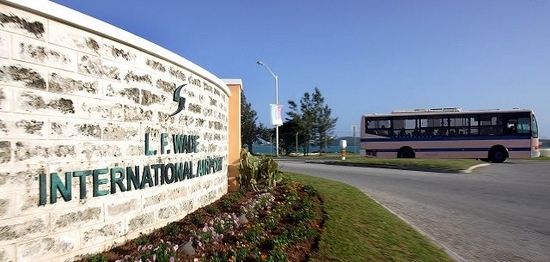
536 acres. Its runway 12/30 is 9,713 feet in length and 150 feet wide. There are eleven taxiways, all 75 feet wide. The terminal apron has eight aircraft parking bays. It is the only airport in Bermuda. It falls under the Bermuda Civil Airports Act 1949, Bermuda Airport Regulations 1959 and Bermuda Airport Amendment Regulations 2002.
Runway facts. LF Wade International Airport has a single active runway, known as 1-2-3-0. Runway 1-2, the portion where aircraft come in over Ferry Reach, has the same amount of asphalt surfacing as 100km of Bermuda’s twin-lane roads. There are also 100km of markings on the 150ft by 9,753ft runway, which has undergone changes since new international regulations. The runway itself dates back to the 1940s, when it was laid down by US forces. Bermuda’s runways are still laid out in the ‘A’ shape characteristic of military facilities, but only the main strip is in use. That leaves the “finger” for fire department exercises, the parking of military aircraft — and future developments such as a proposed solar energy plant. A third strip is known as Taxi Way Bravo, which connects the runway to the “apron” in front of the airport buildings. In order to give adequate clearance for aircraft landing over Ferry Reach, their angle of approach is to be adjusted by two-tenths of a degree — enough for the “threshold” and other landing markings to be moved forward more than 500ft. The alterations, which are required of Bermuda under international standards, will have no effect on take-offs. April 2013 has been set as the final deadline for the project to start.
1 Passenger Terminal, 1 Cargo Terminal, 8 Aircraft Stands. Passengers disembark or embark down or up the aircraft ramp, then walk from or to the aircraft and terminal in all weather. When flights arrive or take off in the rain, passengers get wet. A passenger boarding bridge will be rain cover for embarking or disembarking passengers. Jetways may not be a practical proposition, either in cost or maintenance, especially in the salt-laden Bermuda air and closeness of airport to ocean. A mobile tunnel from terminal to plane steps was not successful in 1995-1996.
Passenger Facilities: Annual Capacity 842,245, 40 check-in desks, 8 gates, 3 baggage claim belts, short term parking spaces, 2 long term parking spaces, Bank, Bars, VIP Lounge, Duty Free Shop, Gift Shop, Tourist Help Desk, Taxi Service/Rank, First Aid.
Elevation 2m (6ft).
Fire Category 8.
Emergency Services are crash fire rescue service, airport security police, Bermuda Police.
Navigational Aids are VOR/DME, SSR.
Airfield Restrictions: None.
Noise Restrictions: None.
Runway 1: Heading 12/30, 2,960m (9,711ft), 80/F/A/W/U, ICAO Cat. 8, Aircraft size max: B777, ILS, Lighting: PAPI, Variable, High Intensity.
Lighting is variable or high intensity. The approach is abbreviated, variable, or high intensity with a precision approach path indicator (PAPI) system on both runways. All runway markings are in accordance with ICAO Annex 14.
Taxiway lighting is medium intensity edge lighting with internally lighted taxiway guidance signs. There is also an aircraft radio controlled lighting system or ARCAL which is available for use between 11 pm and 7 am daily.
Cargo Facilities: Capacity 7,000 tonnes (15,432,000lbs), Warehouse 8,500m² (91,493sq ft), Bonded Warehouse, Aircraft Maintenance, Heated Storage, Mortuary, Animal Quarantine, Fresh Meat Inspection, Livestock Handling, Health Officials, X-Ray Equipment, Security for Valuables, Dangerous Goods, Express/Courier Centre. The cargo terminal has 25,850 square feet.
No airport passenger boarding bridges or jetways (known in the United Kingdom as covered walkways). Bermuda is one of the few international airports without any. A boarding bridge or jet way is the corridor that rolls out from the terminal at most airports to the front door of the aircraft. Nor are there any "at level" crossing points.
The airport is between the waterways of Ferry Reach and Castle Harbor. It is 3 miles south west of the Town of St. George and St. George's Parish, 10 miles east of the city of Hamilton, and 20 miles east of the Royal Naval Dockyard. From all other Parishes, it is via Long Bird Bridge and the Causeway. From here, with US pre-clearance from US Immigration and Customs, all departing passengers bound for the USA, once they arrive at any US airport, are exempted from the often huge Immigration lines so typical of those arriving directly in the USA from Europe. The low-lying Causeway, less than 20 feet above sea level, is a vital link connecting the mainland with the airport and from the latter east to St. George's and St. David's and west to the City of Hamilton and beyond, all the way to Sandys Parish.
From 1948 to 1995, US taxpayers continued to pay all the costs of the airport, runways and adjacent military base - and the separate one in Southampton Parish. For this airport alone, the sum spent by American taxpayers has been estimated at about US2 billion. For half a century, the US Government bore all the cost of runway maintenance, air traffic control, airport fire appliances and much more.
When the US Navy ran the airport until 1995 as part of the former US Naval Air Station at the old Civil Air Terminal, it absorbed the cost, with only notional accounts passed to airlines. With the Bermuda Government now the owner and operator, charges and landing fees increased hugely to Bermuda taxpayers and visitors and have continued that way. However, millions of dollars have been spent in improving and upgrading the airport to a far higher standard than when under US Navy control. More than 400 persons work at the airport.
The airport is open for aircraft operations continuously. However, terminal services are only available from 5 am to midnight. Airport tower services and airport firefighting services are not available from 11 pm to 7 am. During this time the airport operates under non-tower operations and pilots of general aviation aircraft use the ARCAL to activate the airport runway and taxiway lights. The airport operations building has two floors. It is made of a mix of Bermuda stone (limestone), concrete blocks, concrete and wood. The upper floor has 65,300 square feet and the ground floor 172,500 square feet.
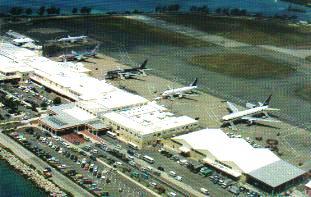 Via the
Federal
Aviation Administration (FAA) agreement between Bermuda and the USA, the FAA provides
air traffic control services for Atlantic air traffic passing through Bermuda air space.
Bermuda provides tower air traffic control services for all flights landing and departing
the Island, to a distance of eight miles. The FAA provides air traffic approach control
services from its New York Center for all flights on behalf of Bermuda.
Via the
Federal
Aviation Administration (FAA) agreement between Bermuda and the USA, the FAA provides
air traffic control services for Atlantic air traffic passing through Bermuda air space.
Bermuda provides tower air traffic control services for all flights landing and departing
the Island, to a distance of eight miles. The FAA provides air traffic approach control
services from its New York Center for all flights on behalf of Bermuda.
Bermuda and the FAA also agreed a number of cost sharing responsibilities in equipment, maintenance and operations. Now installed is an array of navigational aids and communications equipment to help the FAA fulfill its en route and approach control responsibilities. The agreement enables the USA and United Kingdom to fulfill their commitments to the International Civil Aviation Organization (ICAO), while the FAA benefits from enhanced management of air space around Bermuda. Data sent from Bermuda helps reduce time and distance separation restrictions and permits access to the most efficient cruising levels for aircraft.
Air Traffic Control Service is provided from an ATC Tower located on high ground approximately midpoint of the runway on its north side. Departure and Arrival control is provided from New York Air Route Traffic Control Center (ARTCC) at Ronkonkoma, Long Island New York, using radio transmitters and receivers installed in Bermuda and real time feeds of VOR and Radar signals from Bermuda.
Electronic navigation aids include a Category I Instrument Landing System serving runway 30, a VOR/DME serving both runways and a secondary surveillance radar, with a range of approximately 200 miles. Aeronautical information is available in the Bermuda Aeronautical Information Publication (AIP). It may be purchased from the Bermuda Department of Civil Aviation.
The airport has installed an advanced surveillance radar, in a cost-sharing agreement with the FAA.
![]()
For further details on the following for tourists and business visitors, see Getting Around in Bermuda.
![]()
Air routes. Bermuda, as a British Overseas Territory, needs the approval of the United Kingdom for all new air routes but the latter rarely interferes as Bermuda can handle its own charter business. The Bermuda Government, not the British Government, both sets all local aviation laws and approves the charges to and from Bermuda of all the airlines and their changes in schedules.
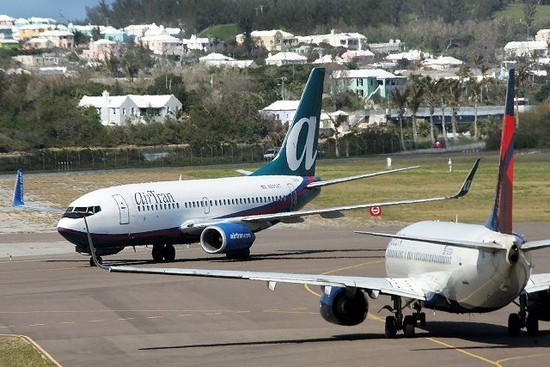
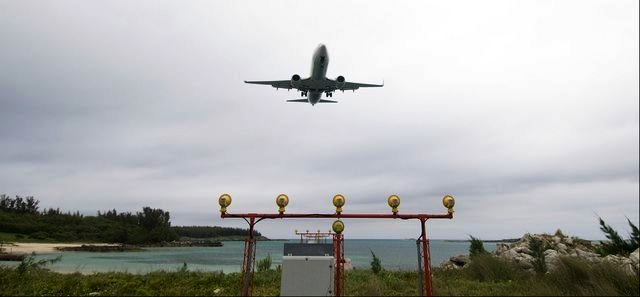
![]()
The airport has several. These are portable devices that under medical supervision deliver a small electrical shock to restore normal heart rhythm during sudden cardiac arrest, a condition that kills countless patients a year.
![]()
![]()
More than 170 aircraft are on this register, owned by foreign nationals but not allowed to operate in Bermuda in transportation of residents or visitors. Most are new, sophisticated and technically advanced corporate jets, owned by very high net worth individuals (such as Bloomberg, Mayor of New York, who has a lavish private home in Bermuda and flies to it frequently).
![]()
Responsible for the regulation and safety oversight of aviation in Bermuda and all aircraft on the Bermuda Aircraft Registry. Previously known as the Bermuda Department of Civil Aviation, which was established in 1931, the new BCAA became a newly formed Authority on October 1st, 2016. Bermuda is a United Kingdom Overseas Territory and though it is regulated by the UK Department for Transport, the safety oversight system is separate from that of the UK. The regulatory requirements are established as the Overseas Territories Aviation Requirements (OTARs), which are in full compliance with the standards and recommended practices of the International Civil Aviation Organization (ICAO). Bermuda’s Aircraft Registry is extensive and ranks 10th in size when compared to the 191 signatory States to the Convention on International Civil Aviation. The current Registry includes a mix of both private aircraft and commercial aircraft operated under Article 83 bis Agreements.
![]()
Airport bars and restaurants are licensed to serve liquor under Bermuda's Liquor License Act 1974, Eastern District.
![]()
![]()
Duty-free exemptions from Bermuda Customs Duty with effect from November 4, 2011 are tiny by USA, Canadian and British -UK standards.
Behind the scenes, drug-sniffing dogs will check your baggage before it appears on carousels.
Visitors may bring in, duty free for personal use only while they are in Bermuda, their clothes and articles like cameras, golf bags, 50 cigars or 200 cigarettes or 0.454 kilos (1 pound weight) tobacco; 1 liter of liquor or wine and a $30 gift allowance (compared to $100 in the USA) . If they bring in any more in gifts or their value, they can be charged a heavy rate of duty - over 25% of value - unlike in USA, Britain and Europe, where it does not matter whether your gifts are for yourself or a member of your family or associate or a complete stranger.
Declare a medically prescribed drug and show the doctor's or pharmacist's code on the prescription.
There is a Customs Duty Payable counter at which to pay your exceedingly high rate of Customs Duty upfront if, as a Bermuda resident or visitor, you exceed your low $100 per person duty-free allowance. Produce receipts from a retail store satisfactory to the Customs Department of actual purchase price of the items or be prepared for the Customs Department to assess items for your payment of duty at much higher Bermuda prices. This is applied vigorously. To avoid being arrested and having goods confiscated, do not try to import goods into Bermuda without paying the duty.
People who refuse to be searched at Customs on arrival at the airport or on a cruise ship or at any time near the airport or ports can be arrested.
Illegal Imports. It applies to those who arrive by air or cruise ship or yacht. The full list of the hundreds of banned narcotics are in the Bermuda Government's Misuse of Drugs Act 1972 and Misuse of Drugs (Controlled Drugs) Order 2001 enacted on August 1, 2001. It is not an excuse if you fail to make yourself familiar with the contents of the full list. Penalties are very severe for those who ignore this warning. Locals, tourists and visitors are not given any breaks. The claims they invariably offer that they do not have the money to pay the fines are routinely ignored. They are remanded in custody or are put on bail with their transportation tickets impounded until they do. Also, there are many other repercussions.
After passing through Bermuda Customs, passengers catch taxis or take pre-arranged minibus transportation to get to their hotels or other guest properties. (There is no public transportation services for tourists with luggage). Hotels are not allowed to provide their own shuttle services between the airport and their hotels.
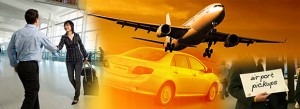
Airport Pickup
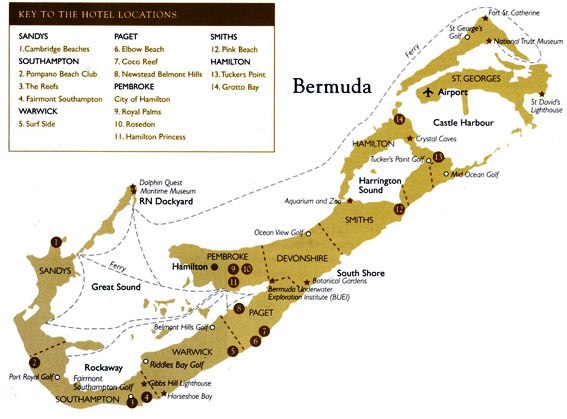
![]()
The British Government's Department for Transport's Access to air travel for disabled people: code of practice is not followed in Bermuda by the Bermuda Government. But a disabled passenger transporter that cost local taxpayers $94,000 was installed in August 2003. It was funded by the Passenger Facility Charge fee. The diesel-powered unit elevates 20 feet off the ground to transport the disabled from terminal gates to the cabin of the aircraft or in reverse. It is fully enclosed, air-conditioned and can board as many as six wheel-chair bound passengers at one time.
![]()
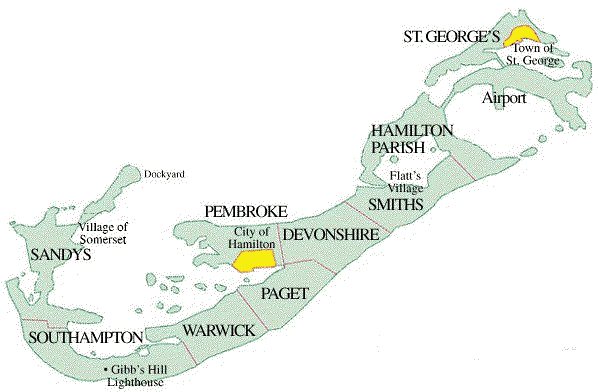
![]()
It bounces radio waves off objects with a high powered antenna. It indicates the comparative velocity of rain drops and other precipitation in the atmosphere. It enables a meteorologist to detect potentially hazardous features such as squall lines and outbursts.
![]()
A two-mile radius circle around the airport, centred at 32°21’52.3”N 64°41’04.0”W.
![]()
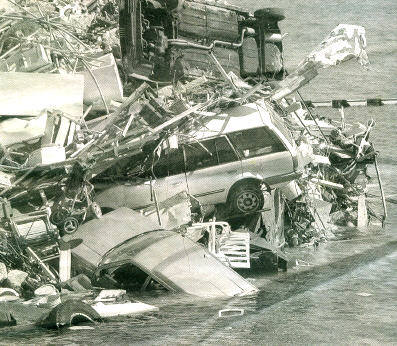
![]()

![]()
A 2004 upgrade replaced the system installed by the US Navy prior to 1995.
![]()
One is a Government-operated car park, with three free reserved spaces for Government vehicles with license plates GP1 (the Premier) to GP20, only. For everyone else, a short-term and long-term car parks are available. Motorists pay by credit card.
![]()

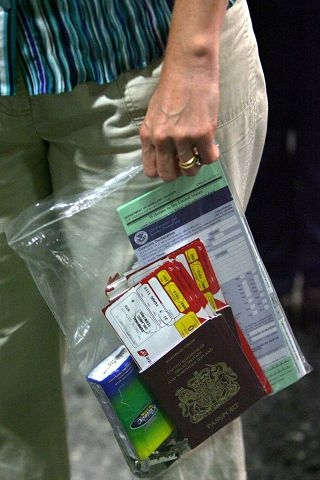
Airport security is contracted out by the Bermuda Government to a private sector security organization, which also provides the Bermuda Airport Security Police. Passenger security is handled by a different security company. It handles the screening of passengers' bags and luggage. Every bag going into an aircraft's hold will pass through an X-ray machine with Threat Image Projection to find images of dangerous objects. Electronic baggage monitoring helps to ensure extra bags are not put on the aircraft. It also helps locate bags of passengers who are detained by authorities from departing aircraft at the last minute. In addition to the Departure Tax per adult, all passengers pay a Bermuda Government Airport Security Fee, added on to the cost of an airline ticket. The fee is structured to recover a portion of the costs incurred to meet the security requirements stipulated by the Bermuda Civil Aviation Authority.

![]()
In June 2013 Bermuda’s new long-range radar at LF Wade International Airport went online. The improved radar extended coverage from 360 miles to 440 miles. The project, undertaken in tandem with the US Federal Aviation Administration (FAA), marks the first significant upgrade of the navigation system since Bermuda’s formal agreement with the US 20 years ago. Under the deal the FAA installs equipment in Bermuda and the Island shares radar surveillance with flight controllers in New York for the FAA to manage aircraft coming in and out of the Island or passing through Bermuda airspace.
![]()
For outgoing passengers. There are duty-free shops in the Departures areas. Once USA passengers pass through the US Customs Pre Clearance Service and enter the USA Departures lounge, they cannot purchase goods which will attract US Import duties because of strict US Customs regulations. If an airport store for departing passengers advertises duty-free liquor prices while there is a big saving on duty-free liquor compared to most retail stores in Bermuda, Canada and United Kingdom prices, passengers bound for New England, Pennsylvania and other US states residents should note that retail prices in their states for liquor may be about the same as Bermuda Duty Free prices. And passengers bound for the UK should note that if they go beyond Gatwick by air they are hugely restricted in what they can take in their hand luggage.
![]()
When completed in 2020, restaurants will be The Whistling Rum Bar & Grill, Rock & Barrel Gastro Bar and The Heron & the Sea Public House. Each location will have full dining and takeaway options. The Whistling Rum Bar & Grill, located before the check-in area, will feature a full-service outdoor patio offering al fresco dining. A landside bar and grill will serve options including jerk roasted chicken, fish tacos, fish chowder and warm rum cake, as well as beer, international wines and sparkling wines, and signature cocktails. Rock & Barrel Gastro Bar, with views over the runway and Ferry Reach, will be located in the US departures lounge. It will feature design elements that draw inspiration from the natural woods, stones and turquoise waters of the island while blending in what it described as “an eclectic industrial vibe”. The full-service gastro bar will feature signature Bermudian cocktails, local and international brews and freshly prepared island dishes, and an open-air full-service patio. The Heron & the Sea will be the main dining option in the international departures area, and will offer a range of beverages in a pub-influenced setting. Bermudian-inspired dishes with a focus on seafood will include fish chowder, scallops, blackened wahoo and shrimp kebabs with guava BBQ sauce. Skyport said the market-style convenience store will be located in the arrivals public meet-and-greet area for those coming in from late flights, offering quick bites and coffee to go.
![]()
Bermuda follows those of the USA's FAA.
![]()
This has not always been in Bermudian hands. When the US Base was stationed in Bermuda, the Americans ran the tower. In 1995, the responsibility for the tower transferred to the Bermuda Government and Canadian controllers were brought in to train Bermudians. By 1996, Bermudians were sufficiently qualified to run the tower. Bermudians are sent to Civil Aviation Authority approved schools in the UK for about three months and then return to Bermuda for practical training. Residents and tourists may not know is that part of the airport transfer agreement left radar reading as New York's responsibility and any flight that wishes to leave Bermuda requires New York approval. Coverage for 200 miles means New York can easily handle flights once they leave Bermuda's airspace on their way to either the US or Europe. Bermuda's airspace is Class D because it only extends up 2,500 feet and within a five square mile radius from the geographical centre of the Airport. Class D is an FAA Classification depending on the aircraft that use the airspace and, all the aircraft that do use the airspace, have to conform to particular radio signals.
During the peak period there are two controllers on duty. One is the local controller, who is responsible for all arriving and departing aircraft into Bermuda and issues landing clearances, departure clearances and provides weather information. He or she will also provide weather information to flights flying over Bermuda. The other controller is the ground controller who is in charge of any vehicles on the runway, giving taxi instructions and route clearances to aircraft departing Bermuda. Emergency situations – such as a diverted airline, a hurricane or the situation involving a terrorist hijacking such as that which happened in September 2001 involving New York, Washington DC and Pennsylvania – begin with a pager call out from New York to RCC Bermuda Radio which relays it to Air Traffic Control, the Fire Department, Department of Airport Operations and the Weather Service. The managers of all the departments will liaise and decide who responds to a call. The work day for an air traffic controller ends at 11 p.m. when they will move through yet another checklist before turning over responsibility to New York, which is able to activate the lights and emergency services. But, as days can never be relied upon to be typical, there is emergency housing near the Airport for air traffic controllers, who may be called upon to remain in the tower for up to two days in emergency situations such as hurricanes.
![]()
2019. October 2. Skyport and Aecon Airport Constructors today advised the public that 20 artists have been short-listed after the Public Art RFP process. After careful consideration, Skyport and Aecon have recommended potentially 20 artists’ pieces for placement within the new passenger terminal building at the LF Wade International Airport. Those artists on the short list will be contacted for further input and clarification of their submissions. Short listed artists will be asked to resubmit their proposals by October 25 at 3:00pm.The final selection of artwork to be displayed within the new passenger terminal building will be decided by November 7 at 5pm. For more information, please contact Carrie Thatcher at 293-2470.
2019. September 30. Four Bermudian companies have been awarded subcontracts for work on the airport redevelopment site, Bermuda Skyport Corporation Ltd announced today. Bermuda Skyport is overseeing construction of the new terminal. Contracts have been awarded for work related to flooring, painting, excavation and masonry works. Stafford Flooring will perform carpet and vinyl flooring installation. Mathias Pro Contractors has been awarded a contract for painting work. D&J Construction was awarded a stucco wall treatment contract for ancillary buildings including the gatehouse, concessions building, and water feature. Concrete tank construction for the waste water treatment plant was awarded to Correia Construction Ltd. That contract also includes installation of sidewalks and curbs. Frank Ross, executive director, infrastructure, at Aecon, said: “We are pleased again to award more Bermudian companies with subcontracts for the airport redevelopment project. “The important work these companies will perform marks an exciting phase in the construction of the new airport terminal.” The redevelopment at LF Wade International Airport is expected to be completed in 2020.
2019. July 12. A $2 million plus weather radar system will be operation next week, the transport minister told MPs this morning. Zane DeSilva said the Doppler radar system, on Cooper’s Island, had been completed on time and under budget. Mr DeSilva said a new system was needed because the ageing radar equipment had suffered a series of breakdowns. The German-built system was installed with the help of island technicians and weather service staff were trained in the use and maintenance of the radar gear. Mr DeSilva said: “Together with a the planned life cycle maintenance programme, this training will help ensure an expected 95 per cent system reliability over the life of the system.” He added the Airport Authority, set up in 2017, to monitor airport operators Skyport and manage air navigation services, had identified the need for new weather radar as “mission critical”.
2019. June 27. Bermuda Skyport and Aecon Airport Constructors are calling for Bermudian artists to submit works of art to be displayed in the new passenger terminal building scheduled to open in the summer of 2020.
2019. August 9. Skyport has reached out to the public for used luggage to test baggage equipment at the new passenger terminal building. A Skyport spokeswoman said those who donate luggage will be given “tags” for a monthly draw, with prizes to include gas vouchers, grocery vouchers and gift cards. Mikaela Pearman, marketing and communications officer at Skyport, said: “A fully functioning baggage handling system is an integral part of an efficient airport terminal. Skyport, along with its partners in the programme will be conducting tests and trials of the system and we encourage members of the community to donate old luggage they are no longer using, so that we can test the system efficiently. The testing of equipment brings us one step closer to opening a world-class airport for Bermuda.” Skyport said the new baggage system was installed by Glidepath, a New Zealand-based company with nearly 50-years of experience in delivering airport baggage handling and integrated security screening systems. The Skyport spokeswoman said: “The baggage handling system is used to carry bags checked in by passengers, from the flight check-in desks to a holding area where they are then driven to their plane on baggage carts. The complex system is rigged in the ceilings of the first floor of the new building. It consists of 242 Conveyors totaling almost 3.5 kilometers in length traveling up to 1.8 meters per second. In addition to transporting bags to the flight loading location, the system software will maintain the passenger information for each bag and monitor its position along the conveyor belts.” Those interested in donating baggage are asked to e-mail orat@skyport.bm or call 299-4832 by December.
2019. May 4. A flock of Bermuda kites have been selected to decorate the new LF Wade International Airport terminal as part of a competition. Aecon and Skyport, who hosted the competition, said the 155 entries and more than 200 designs were submitted as part of the competition to select ten winning designs. Lily Mulder-Powell, Mikale Willis and Kiera Wales were named winners in the 12-and-under category, while two entries by Priel Minors were selected as the winners in the 13 to 18-year-old category. Brian Lightbourne, Matthew Tumbridge, Abigail Kempe, Steven Harvey and Jordon Every were selected as winners in the adult category. In addition to seeing their designs hanging in the new airport terminal when it opens next year, each of the winners was presented with a $250 cheque at a special reception. Frank Ross, executive adviser for infrastructure at Aecon Construction, said: “We were so pleased with the creativity, use of colors and uniqueness in each kite. The installation is going to be visually stunning and we are excited to share it with the public once the terminal opens next year.” Mikaela Pearman, marketing and communications officer at Skyport, added: “Our winners include children from both public and private schools and a diverse group of adults. We were overwhelmed by the large amount of entries we received in the contest and would like to thank the public for its engagement.”
2019. May 2. The switch from the existing terminal to the new one at LF Wade International Airport will happen overnight. It is a daunting logistical challenge, and even though the change over is more than a year away, major planning is under way. Construction of the new terminal is on schedule to be completed in July 2020. A date for the opening of the 277,300 sq ft facility has not yet been set. Aaron Adderley, president of airport operator Skyport, said: “We are right on target. We are engaging in what we call an operational readiness programme, working with all the stakeholders in planning the transition from the existing terminal over to the new terminal. That transition is going to happen overnight, so there is a lot of planning that goes with facilitating that transfer.” He said Skyport is working with other agencies, including airlines, the Government, and customs and immigration, to ready for the switchover. “We are working with everyone who has a presence at the airport to define exactly what the needs and requirements are, to ensure that we have a smooth transition in 2020.” Mr Adderley said everything was going “full steam ahead”, and he was happy with the progress being made. He said everyone was looking forward to moving in to the new terminal, and added: “From our standpoint, Skyport and Aecon, we are committed to delivering the terminal building on time, and we are well on our way to doing that.” The opening of the new terminal might coincide with announcements of a new flight, or flights, to the island. Skyport, the Bermuda Tourism Authority and the Bermuda Airport Authority, are working to attract new flights, according to Mr Adderley. He said: “Collectively we are constantly in dialogue with a number of carriers, not only incumbent carriers but also new carriers. The idea is to look towards getting additional services, whether it be from secondary markets in the United States, perhaps other Canadian gateways, and also the UK/Europe. We have a number of balls in the air, and we are planning and hoping that next summer one of those will materialise and we will have a new flight, or a couple of new flights, [either then] or shortly thereafter.”
2019. March 22. The national security minister told MPs today that drones had been spotted in restricted airspace at the airport. The sightings came despite a no-fly zone of 2.3 miles being imposed earlier this month. Wayne Caines said similar regulations are in place for Westgate prison, where three drone sightings in recent weeks were suspected to be attempts to drop contraband inside. The police headquarters at Devonshire’s Prospect are also off limits and Mr Caines warned owners of the unmanned craft to respect the privacy of property owners. But he said the Government’s had no plans to ban the mini-aircraft.
2019. March 19. The Bermuda Airport Authority will upgrade the island’s weather radar system in time for the next hurricane season — but the work will result in a three month outage. The authority will begin to dismantle the existing system on March 31, but the Bermuda Weather Service will provide other types of weather graphics including satellite images. Lester Nelson, chief executive of the BAA, said: “The weather radar is a popular resource for weather tracking therefore the installation has been planned to take place between the end of winter and prior to the height of hurricane season.” A spokeswoman for the BAA added the weather radar system is part of a series of ways used by Bermuda the weather service to provide the public with information. She added: “Its outage will not impact aviation safety. It is planned for the new weather radar system to be available to users by July 15.”
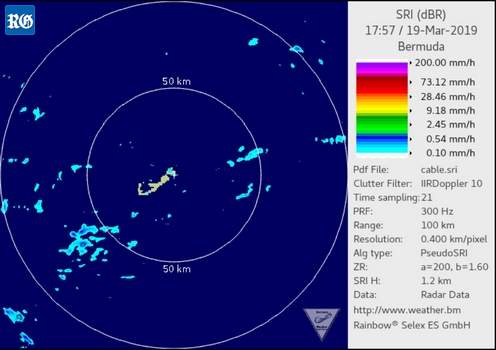
2019. March 18. L. F. Wade Bermuda International Airport has been declared off limits, a no-fly zone, for drone flights, by the Civil Aviation Authority. Breaching the rules could come with a fine of up to $4,000, the authority warned. According to Thomas Dunstan, director general of BCAA, drones are growing in popularity, which heightens safety and security challenges. The restrictions also apply to micro lights, gliders, airships and balloons, with no-fly zones set as a two-mile radius circle around the airport, centred at 32°21’52.3”N 64°41’04.0”W.
2019. February 8. A bus stop near the airport will be removed to make way for the development of the new passenger terminal. The transport ministry said the stop next to the roundabout connecting the Causeway, Kindley Field Road and Cahow Way will be out of action from Monday. A spokesman said: “The removal of this stop is expected to have minimal impact on service delivery and all buses will continue to service the existing airport facility via Cahow Way. “The new airport will also feature an on-site bus stop providing convenient access for the public.”
2019. January 31. The Bermuda Civil Aviation Authority (BCAA) this week hosted members of the UK Air Accident Investigation Branch who facilitated a workshop offering guidelines to the local aviation community on what to do in the event of an aviation accident or serious incident occurring in Bermuda. Representatives from BCAA were joined by Skyport, the Bermuda Airport Authority, Airlines, CI2, Bermuda Police Service, HM Customs, Bermuda Hospitals Board, the Bermuda Red Cross and several other organizations and spent two days learning the latest techniques in uncovering the causes of accidents - including those of illegal drone flying. The AAIB is the organization appointed by the Governor of Bermuda, who is responsible for carrying out air accident investigations, to perform these services. Under the International Civil Aviation Organization (ICAO) Convention on Civil Aviation, States must establish and appoint an organization responsible for air accident investigations, which is separate and independent from the Civil Aviation regulator, which in Bermuda is the BCAA. The aim of any air accident investigation organization is not to apportion blame but to uncover the root cause of any accident so lessons may be learned and improvements can be made to prevent similar issues from recurring. The presentations invoked much discussion and were followed by practical exercises of various scenarios in the local area.
2019. January 25. Completion of roofing on the airport’s new terminal building was marked yesterday with a traditional roof-wetting ceremony. Aaron Adderley, the president of airport operator Skyport, said the event was a “magnificent milestone”. Construction on the new passenger terminal building at LF Wade International Airport began in March 2017. Mr Adderley said: “It wasn’t that long ago when we broke ground, and here we are, steadily moving along towards a completed, state-of-the-art facility. Thanks to the excellent workmanship on the site, the project is on schedule and due for completion next year.” Steve Nackan, the president of developer Aecon Concessions and chairman of Skyport, added: “Bermuda is now one step closer to having a world-class, modern airport terminal for Bermudians and visitors alike to enjoy. I would like to thank our partners on this project, including the Government of Bermuda, Bermuda Airport Authority, the Government of Canada, all the subcontractors, workers and the Bermuda community at large.” Zane DeSilva, the Minister of Tourism and Transport, Martin Zablocki, the president and chief executive of the Canadian Commercial Corporation, and Frank Ross, the executive adviser with Aecon Infrastructure, also attended the event. A special bottle of Gosling’s Black Seal Rum was used for the ceremony. Structural work was completed last November and was marked with a steel-topping ceremony, a Canadian tradition. The building is expected to be finished in the summer of 2020.
2018. November 23. Tourism minister Zane DeSilva accused Skyport today of passing some of its financial burdens on to the taxpayer. Mr DeSilva told the House of Assembly that the company running the airport now receives 100 per cent of revenues from passengers’ ticket fees and airline fees for landing, cargo and fuel. He said that Skyport is not making payments for the airline incentives it receives in the form of a minimum revenue guarantee. Mr DeSilva told MPs: “As a part of the airport deal, and since March 2017, Aecon and Skyport are now responsible for the marketing, business development and planning to increase the volume of air traffic and passengers to maximize Airport revenues. It is important to note that Skyport receives 100 per cent of the airport revenues from what each passenger pays in ticket fees and what each airline pays in landing, cargo and fuel throughput fees. This is a deliberate term of the airport deal which means that revenue that used to come to the Government of Bermuda now goes wholly and solely to Skyport. When MRGs were the responsibility of the Government of Bermuda, the responsibility to pay for them was, as you would expect, the Government’s. Honourable Members and the public may be surprised to learn that in spite of now having this responsibility, Skyport has determined that it should not be responsible for making payments under the MRGs. It appears that Skyport is content to have the authority but not the responsibility. The airport deal seems to have empowered Skyport to pass this burden on to the Bermudian taxpayer. This Government was elected with a mandate to relieve the burdens of the hardworking, taxpaying families in this country. In a deal that has deprived them of a vital, national asset — as well as the significant revenues that it generates — it is unthinkable that we would sit idly by while taxpayers are forced to bear a financial responsibility that rightly rests with Skyport.”
2018. September 20. The LF Wade International Airport has been named the most improved flight terminal serving under two million passengers. The accolade came from the Airport Service Quality programme, which is run by Airports Council International, a global organisation with a membership of almost 2,000 airports. The ranking for Bermuda came for the second quarter of 2018. Bermuda went up from 55th in the first quarter to sixth in quarter two, and ranked as a top-ten airport for service quality, in a survey of 65 airports. Bermuda Skyport took over management of the airport in March last year under a 30-year concession agreement. The company has carried out “major upgrades” to the old terminal building as it oversees the construction of a new airport. Aaron Adderley, the president of Skyport, said the upgrades to the present terminal had been made “despite knowing that it would eventually have to be demolished”. Mr Adderley added: “Until we move to the new facility in 2020, nearly two million passengers are expected to use the existing one, and thus we felt the investment was warranted to help ensure an improved travel experience for such a significant number of passengers. I think the ASQ survey results suggest that it was money well spent and, more importantly, highlights the hard work being put in by so many different agencies at the airport, including customs, immigration, retail, airline and ground services personnel. Collectively, though, we will aim to improve even further.” Lucinda Pearman, the Collector of Customs, said that the arrivals hall and immigration primary teams had produced “excellent results”. She added: “This accomplishment is particularly impressive and noteworthy coming from one of the smallest customs departments in the world. Our team has often worked extra-long hours during the peak period to facilitate arriving passengers, yet has kept a high level of professionalism, diligence and dedication throughout and in doing so, has significantly contributed to the airport’s success.” LF Wade International Airport improved in several categories including overall satisfaction, courtesy and helpfulness from check-in staff, security and other airport staff, flight information screens, wi-fi, cleanliness of the terminal and washrooms and customs inspection. Skyport said services provided by agencies including the Bermuda Government, security firms, US Customs Border and Protection and the ground handlers also helped to drive the overall improvement.
2018. March 17. Bermuda’s controversial contract to build a new airport has won an international “deal of the year” award. The public-private partnership contract was awarded 2017 North American Deal of the Year at a ceremony in New York organized by London-based IJGlobal Magazine, a top specialist publication in project finance and construction. Bob Richards, the finance minister in the last One Bermuda Alliance government, who spearheaded the project amid public protests, said last night the news had “put a smile on my face”. Mr Richards, who lost his Devonshire East seat in last July’s General Election, said: “I hope Bermudians now understand the difference between facts and political spin. It was so controversial here and I’m glad it’s got the recognition it deserves.” The award was presented at the IJGlobal Awards gala at New York’s Mandarin Oriental Hotel on Thursday. The airport deal will also now appear in the spring edition of the magazine alongside other winners. Mr Richards said he knew the deal with the Canadian Commercial Corporation and developers Aecon was even in the running only when a friend in New York phoned him yesterday to tell him the airport deal had won. Mr Richards said: “I’m extremely pleased. I’m very proud and it’s an indication of the good work we did. It’s not just vindication — it’s really good, it’s an international award, away from Bermuda and Bermuda politics.” He added: “It’s a confirmation of the good work we did and proof of what we’ve been saying all along.” The deal was opposed by the Progressive Labour Party and sparked public protests. A report by overseas consultant LeighFisher released last month said cancellation of the deal only months into the start would have cost more than $100 million. It added that the island’s struggling economy would have suffered even more damage if the Government had pulled out of the contract, with job losses, “economic damage and instability, international reputational risk, threat of credit rating downgrades and negative impact on tourism”. The report found that the terms and conditions of the contract were “broadly consistent” with similar public-private deals and the interest rate for long-term debt and the return on equity for Aecon were “within market range”. But the LeighFisher report said the project was not competitively tendered, which could increase negotiating leverage, maintain competition and lead to best value for money. But Mr Richards said at the time that a competitive tender would not have worked for such a small project because Bermuda could not have compensated unsuccessful competitors for the work they put into a detailed bid. David Burt, the Premier, announced the contract would not be cancelled because it would be “fiscally irresponsible” and cost at least $196 million. The report identified about $15 million in “enhancements” that could be negotiated and Mr Burt said he would work to get “the best possible outcomes from this situation”. An independent Blue Ribbon Panel set up by the OBA last year to examine the deal found it was “commercially sound and reasonable and likely to meet the Government’s stated objectives of long-term sustainability and increased traffic volume and revenue”. The panel was made up of five on-island financial experts chaired by Malcolm Butterfield, a retired managing director at professional services firm KPMG. Mr Butterfield said: “Overall, the panel’s view is that this is a good deal. It’s not perfect.” A protest against the redevelopment in December 2016 turned violent when police officers clashed with demonstrators who blocked entry to the House of Assembly. Officers used pepper spray on the crowd outside Sessions House. Mr Burt, who was then Opposition leader, Derrick Burgess, Lovitta Foggo and Lawrence Scott were among the PLP MPs who showed up to picket Parliament. At least 26 complaints were made to the Police Complaints Authority by members of the public in the wake of the demonstration. The Bermuda Police Service said 14 of their officers were assaulted. The Premier did not respond to a request for comment.
2018. February 23. The contract on the controversial airport deal will not be scrapped, the Premier announced yesterday. But David Burt pledged that the Government would work through the “bad deal and do all that we can do to realize some good for the people of whom we serve”. Mr Burt said the price tag for cancellation of the deal to rebuild LF Wade International Airport was “a minimum” of $196 million and that it would be “fiscally irresponsible” to axe the contract. Mr Burt added: “In fact, it would be just as fiscally irresponsible as it was for the former OBA government to enter into this contract in the first place.” He was speaking as he unveiled a review of the contract ordered by the Government. The 25-page review was prepared by LeighFisher for the Bermuda Airport Authority and is now available on the Government’s website. Mr Burt said the deal struck “stands as a stain on the relationship between a government and the people it is meant to serve”. He added that the review was ordered to see whether or not Bermuda could get a better deal on the contract signed with the Canadian Commercial Corporation and developers Aecon. Mr Burt added: “That was the intent of the report, that is what was stated inside of our election platform, and that was what the reviewers were meant to execute.” The review outlined two scenarios for consideration — “optimising” of the current contract through “incremental enhancements of key elements”, and termination of the contract. LeighFisher said the termination provisions within the contract were “typical for P3 projects”. The report warned that the “unintended consequences of termination” would include loss of jobs, economic damage and instability, international reputational risk, the threat of credit ranking downgrades, and a negative impact to tourism. LeighFisher said that the contract’s lack of variation provisions was “extremely unusual. The only way to make substantive changes to its terms and conditions is to terminate the agreement.” Mr Burt said the lack of clauses in the deal to allow for changes was the “most shocking” element unveiled by the review. He added: “This is one shameful and degrading failure by the OBA, and maybe the most heinous aspect of the entire agreement.” The review identified six “optimisation elements” that could be pursued to obtain “incremental enhancements for a better deal”, which would represent about $15 million worth of enhancements for Bermuda. Mr Burt said that the review was the “initial examination” of the deal. He added: “We will not rest until we achieve the best possible outcomes from this situation.” Mr Burt said: “The Government remains convinced that this is a bad deal for the country. We are going to make sure that we hold true to our platform promise to make sure that the people of this country get a good deal. We do not believe that this is the best deal that we can get.”
2018. February 13. The Chinese takeover of Aecon — the company overseeing the construction of Bermuda’s new airport terminal — is being delayed after the Canadian Government ordered a full national security review of the deal. State-owned CCCC International Holding Ltd wants to buy Toronto-based Aecon for $1.5 billion in a deal approved by the Canadian construction company’s shareholders in December last year. Aecon said last October on the announcement of the deal that the takeover would make no difference to the airport project, nor the guarantee in place from the Canadian Commercial Corporation, and that the new terminal will be completed in 2020, as planned. Yesterday Aecon’s shares fell 1.8 per cent on the Toronto Stock Exchange after the extended national security review was revealed. Aecon said the planned date for completing the takeover plan with CCCCI had been pushed back to March 30 from the original date of February 23. “Both companies remain committed to working with the Investment Review Division to obtain approval of the transaction,” Aecon said. Aecon said it had received notice from the Canadian Government that the federal cabinet had ordered a continuation of the national security review under section 25.3 of the Investment Canada Act. That section allows the Government to order a review if the minister “considers that the investment could be injurious to national security”. CCCI has attracted controversy before. The World Bank banned the firm from bidding on construction projects for eight years until January 2017 due to a bid-rigging scandal in the Philippines. Chris Murray, of AltaCorp Capital, believes Ottawa’s primary concern may be Aecon’s telecom infrastructure group, which builds significant core communications networks for several major Canadian carriers. “While we remain positive about the closure of the transaction, we are cognizant that at this juncture, this is now a political process, which adds layers of complexity and uncertainty,” Mr Murray wrote in a report. And he added that he believes the transaction may be a “bargaining chip in Canada-China” trade discussions. Federal Innovation Minister Navdeep Bains ordered the review on the recommendation of Canadian security agencies. Mr Bains’ press secretary, Karl Sasseville, told the Globe and Mail newspaper: “We follow the advice of those who actually have the information and intelligence necessary to make these determinations: our national-security agencies. We will continue to do our diligence to review the potential national-security ?implications, as we have been doing since day one. We never have and we never will compromise on national security.
2018. January 19. The Bermuda Airport Authority has opened new offices at Southside in St David’s.
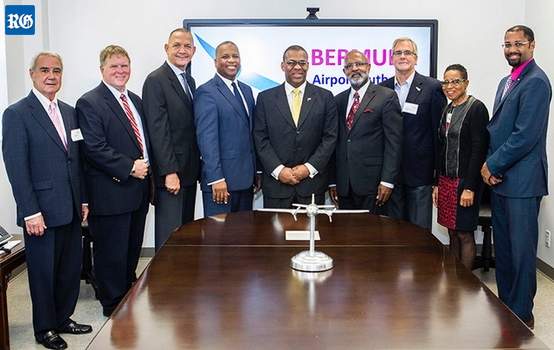
From left above, Ian MacIntyre, Robert Steynor, Marshall Minors, CEO Lester Nelson, Walter Roban, Deputy Premier and Minister of Transport and Regulatory Affairs, chairman Mark Fields, deputy chairman Andrew Parsons, Judith Hall-Bean, Lawrence Scott (Photograph supplied).
Mark Fields, chairman of the organisation tasked to oversee the management, operations and redevelopment of the airport, said: “Our organisation is less than a year old. “We essentially started from nothing, but we are pleased with the leadership of the Authority’s chief executive officer, Lester Nelson, in moving quickly to establish a strong, experienced team of aviation, engineering and financial professionals, as well as internationally recognized technical advisers to oversee Bermuda’s interests in this large and important infrastructure project.” The Authority, which owns the airport on behalf of the Government and people of Bermuda, was established on March 2 last year. It was set up to ensure contractual value is delivered throughout the 30-year public-private partnership with Bermuda Skyport Corporation. The authority’s responsibilities also include air traffic control, meteorological services, aeronautical information services, and airport rescue and firefighting. The Authority is also responsible for regulating fees and charges. Walter Roban, the Deputy Premier and Minister of Transport and Regulatory Affairs, said: “I’m delighted to join the Bermuda Airport Authority board and staff in welcoming stakeholders this afternoon. I’m happy to say that the authority has moved quickly to position themselves in this important role. The LF Wade International Airport is Bermuda’s only air link to the rest of the world and therefore it is vital to our economic lifeblood, essential to international business and tourism. We are happy to have these highly qualified Bermudians involved in the protection of our collective interests.”
2017. October 26. The company building the island’s new airport terminal has agreed to be taken over by a Chinese firm. But Aecon emphasized that it will be “business as usual” with the airport redevelopment project. CCCC International Holding, a subsidiary of China Communications Construction Co, will buy Aecon for $1.5 billion, or $20.37 per share, in an all-cash deal. Aecon is the prime contractor on the airport project, under a public-private partnership involving the Bermuda Government and the Canadian Commercial Corporation. The Canadian construction firm said in August this year that it had hired advisers to help it find a buyer. Steve Nackan, president of Aecon Concessions and chairman of Skyport, the company overseeing operations at LF Wade International Airport, said nothing would change in Bermuda after the takeover. “We wish to confirm our steadfast commitment to Bermuda and the airport redevelopment project,” Mr Nackan said. “It is business as usual at Aecon and on the Bermuda airport terminal construction project. This agreement will create value for our shareholders and enhance Aecon’s capabilities and growth potential, something that we’re very excited about. By joining the third-largest construction company in the world, Aecon and Skyport will ultimately benefit from enhanced capabilities and financial resources. However, Aecon will remain a Canadian company. This sale will have no impact on the day-to-day construction of the new airport terminal or Skyport. The Aecon management team and friendly Bermudian Skyport employees will remain in place and the new airport will be completed on time and on budget with the guarantee of the Canadian Commercial Corporation. We look forward to delivering a state-of-the-art terminal in 2020.” Lu Jianzhong, the president of CCCCI, said: “This is an excellent fit for both of our companies. Aecon has a strong management team and a very impressive track record that have made it a leading construction company in Canada and a pioneer in public-private partnerships and concession operations. It will now gain access to significant capital, complementary infrastructure expertise and an international network to support its growth ambitions.”
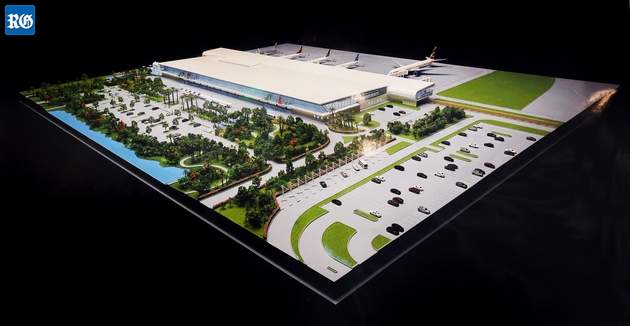
Artist's impression of new airport
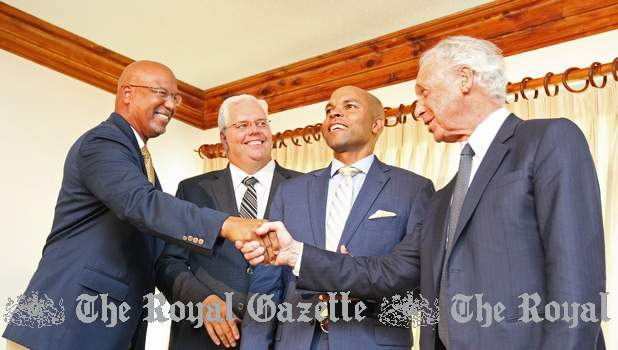
Airport deal signed.
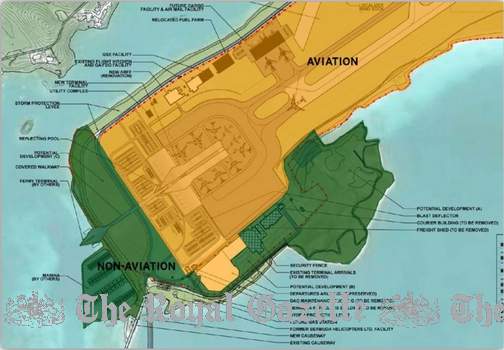
2014 Airport improvement plan
![]()
![]()
Authored,
researched, compiled and website-managed by Keith A. Forbes.
Multi-national © 2020. All Rights Reserved